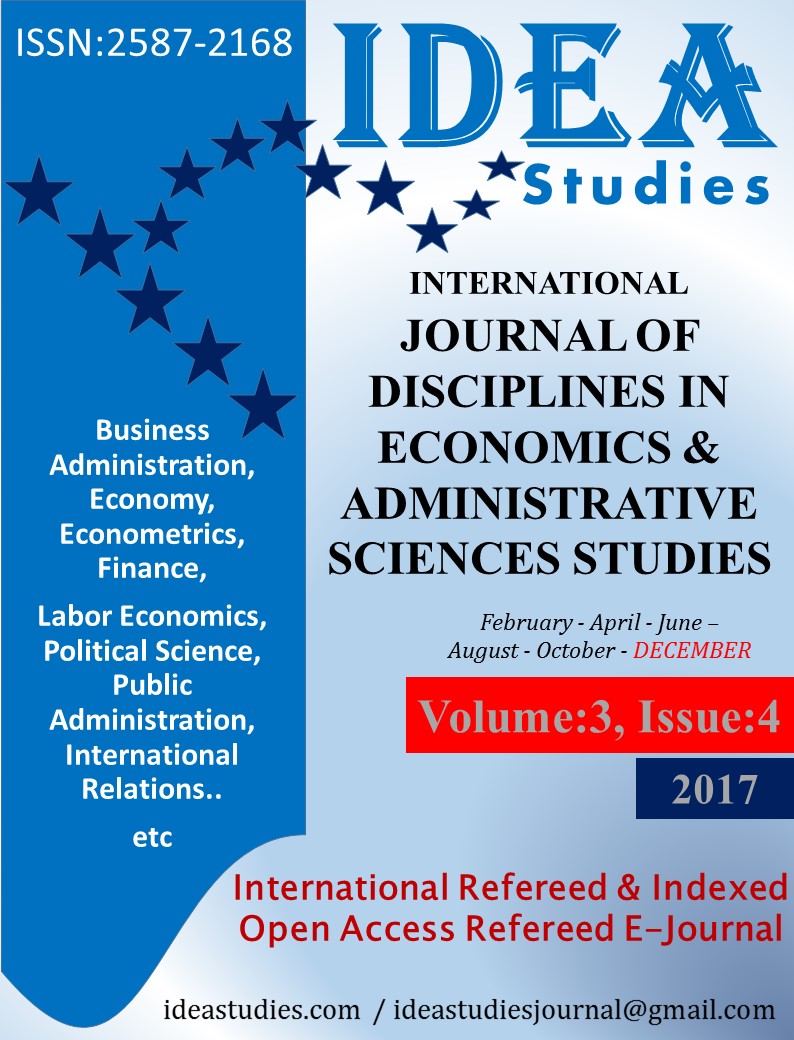Author :
Abstract
Faiz oranları ile döviz kurlarının ilişkisi daima ilgi çeken bir konu olmuştur. Bu sebeple, bu çalışmada 1930 yıllarında gerçekleşen Büyük Buhran sonrasında en büyük ikinci kriz olan 2008 finansal krizi sırasında bu ilişki analiz edilmiştir. Analiz, yüksek faiz oranlarının döviz kurlarını düşürme etkisi olup olmadığını göstermeyi hedeflemektedir. Ekim 2008 ve Aralık 2009 tarihleri arasındaki haftalık veri ile ARDL Model uygulanmıştır. Analiz sonucunda faiz oranları ile döviz kurları arasında kısa vadeli bir ilişkiye rastlanmazken; uzun vadede, pozitif bir ilişki tespit edilmiştir. Bunun anlamı, yüksek faiz oranları uzun vadede döviz kurlarında artışa sebep olmaktadır.
Keywords
Abstract
As the discussion on the relationship of interest rates and exchange rates is always a hot topic, this paper aims to analyze this relationship during 2008 financial crisis, which is the second global crisis after the Great Depression of 1930s, whether higher interest rates had the effect of defending exchange rates thus appreciating them. Applying an autoregressive distributed lag model (ARDL) to weekly data between October 2008 and December 2009, it can be concluded that there is no relationship in the short-run but there is a positive relationship in the long-run meaning that higher interest rates are associated with depreciation of exchange rates in the long-run in line with the revisionist view.
Keywords
- Agenor, P. R., C. J. McDermott, and E. M. Ucer (1997). "Fiscal Imbalances, Capital Inflows, and
- Agenor, P. R., C. J. McDermott, and E. M. Ucer (1997). "Fiscal Imbalances, Capital Inflows, and the Real Exchange Rate: The Case of Turkey," IMF Working Paper no. 97/1.
- Bal, O. (2012). “Döviz Kuru, Mevduat Faiz Oranı, Enflasyon ve Devlet İç Borçlanma Senetleri İlişkisi (1994-2008)”. Akademik Bakış Dergisi, 31.
- Berument, H. (2001). "Measuring Monetary Policy for A Small Open Economy: Turkey," Bilkent University Working Paper.
- Cho, D. and K. D. West (2001). "Interest Rates and Exchange Rates in the Korean, Philippine andThai Exchange Rate Crises," forthcoming in M. Dooley and J. Frankel (eds.), Managing Currency Crises in Emerging Markets.
- Central Bank of Turkey (2010). “Monetary Policy Exit Strategy”, April 2010, No:2010-19.
- Central Bank of Turkey (2010). “Opening Speech for the 78th Ordinary Meeting of the General Assembly by Durmuş Yılmaz”, 20 April 2010.
- Dash, P. (2004). “The Relationship between Interest Rate and Exchange Rate in India”. SixthAnnual Conference on Money and Finance in the Indian Economy, March 25-27, Mumbai. (Erişim: http://www.igidr.ac.in/~money)
- Dekle, R., C. Hsiao, and S. Wang (2001). "Do High Interest Rates Appreciate Exchange Rates During Crisis?: The Korean Evidence," Oxford Bulletin of Economics and Statistics, 63 (3).
- Dekle, R., Hsiao, C. and Wang, S. (2002). “High Interest Rates and Exchange Rate Stabilization inKorea, Malaysia and Thailand: An Empirical Investigation of the Traditional and Revisionist Views”, Review of International Economics, 10 (1), 64-78.
- Dickey, D.A. and Fuller, W.A. (1981). “Likelihood Ratio Statistics for Autoregressive Time Series with a Unit Root”, Econometrica, 49 (4), 1057-1072.
- Engle, R.F. and Granger, C.W.J. (1987) Cointegration and Error Correction: Representation, Estimation and Testing, Econometrica, 55 (2), 251-276.
- Erer, E., Erer D., Çayır, M. and Altay, N.O. (2016), “TCMB, FED ve ECB Para PolitikalarınınTürkiye Ekonomisi Üzerindeki Etkileri: 1994-2014 Dönemi Analizi”, Sosyoekonomi, Vol. 24(29), E-Views Software Booklet
- Furman, J. and J. E. Stiglitz (1998). "Economic Crises: Evidence and Insights from East Asia", Brookings Papers on Economic Activity, Vol.2, 1-135.
- Goldfajn, I. and T. Baig (1998). "Monetary Policy in the Aftermath of Currency Crisis: The Case of Asia", IMF Working Paper no. 98/170.
- Goldfajn, I. and P. Gupta (1999). "Does Monetary Policy Stabilize the Exchange Rate Following a Currency Crisis?," IMF Working Paper no. 99/42.
- Gould, D. M. and S. B. Kamin (2000). "The Impact of Monetary Policy on Exchange Rates DuringFinancial Crises," Board of Governors of the Federal Reserve System International Finance Discussion Papers no. 669.
- Gujarati, N. Damodar (1978). Basic Econometrics, McGraw-Hill International Editions.
- Gül, E., Ekinci, A., Özer, M. (2007). “Türkiye’de faiz oranları ve döviz kuru arasındaki nedensellik ilişkisi: 1984–2006”, İktisat İsletme ve Finans, 22 (251), 21-31.
- Gümüş, İ. (2002). “Effects of the Interest Rate Defense on Exchange Rates during the 1994 Crisis in Turkey”, TCMB Working Paper, No: 14.
- Karaca, O. (2005). “Relationship between interest rate and foreign exchange rate: is decreasinginterest rate increasing the exchange rates ?”, Turkish Economic Association Discussion Paper 2005/14 (www.tek.org.tr).
- Kraay, A. (2000). “Do High Interest Rates Defend Currencies during Speculative Attacks?”, World Bank Policy Research Working Paper, No: 2267.
- Mamak Ekinci, E.B., Alhan, A., Ergör, Z.B. (2016). “Parametrik Olmayan Regresyon Analizi: Faizoranı, Enflasyon ve Döviz Kuru Arasındaki İlişkinin İncelenmesi Örneği”, Bankacılık ve Sigortacılık Araştırmaları Dergisi, Cilt: 2, Sayı: 9.
- Sever, E., Mızrak, Z. (2007). “Döviz Kuru, Enflasyon ve Faiz Oranı Arasındaki İlişkiler: Türkiye Uygulaması”, SÜ İİBF Sosyal ve Ekonomik Araştırmalar Dergisi, 265-283.





